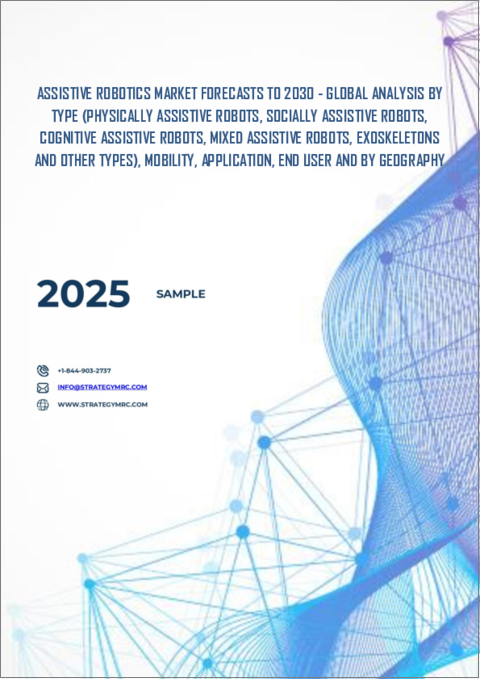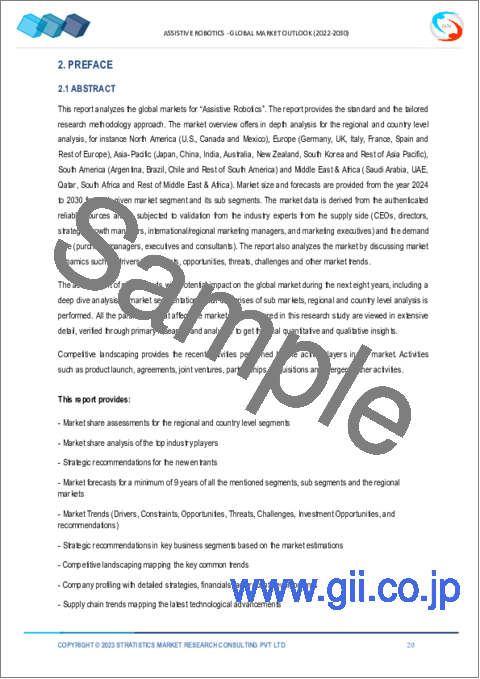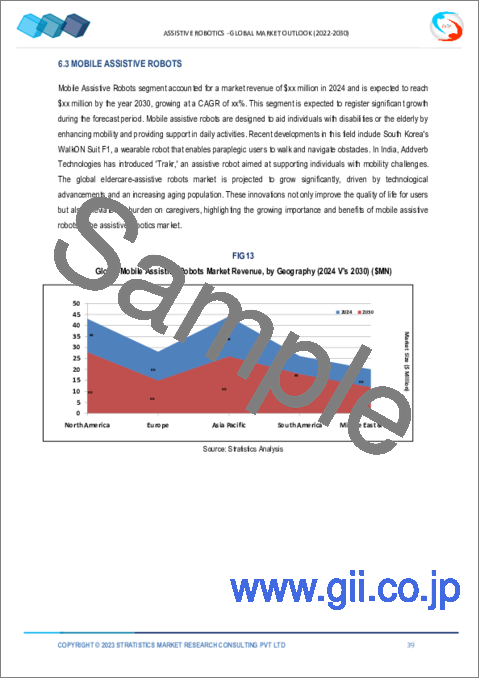|
|
市場調査レポート
商品コード
1617220
支援ロボット市場の2030年までの予測: タイプ別、モビリティ別、用途別、エンドユーザー別、地域別の世界分析Assistive Robotics Market Forecasts to 2030 - Global Analysis By Type, Mobility, Application, End User and By Geography |
||||||
カスタマイズ可能
|
|||||||
| 支援ロボット市場の2030年までの予測: タイプ別、モビリティ別、用途別、エンドユーザー別、地域別の世界分析 |
|
出版日: 2024年12月11日
発行: Stratistics Market Research Consulting
ページ情報: 英文 200+ Pages
納期: 2~3営業日
|
全表示
- 概要
- 図表
- 目次
Stratistics MRCによると、世界の支援ロボット市場は2024年に121億米ドルを占め、予測期間中のCAGRは24.3%で成長し、2030年には448億米ドルに達する見込みです。
アシストロボットは、障害者や高齢者など、日常生活やヘルスケア、職場作業で手助けが必要な人を支援することを目的としたロボット工学の専門分野です。これらのロボットは、ユーザーの生活の質を高め、自立を促し、一人では困難または不可能な作業を代行することで身体能力と認知能力の両方を向上させるように設計されています。支援ロボットには、移動プラットフォーム、ロボットアーム、インテリジェント義肢、外骨格などがあります。これらのロボットは、センサー、人工知能、機械学習、人間とロボットの相互作用システムなどの最先端技術を活用し、ユーザーの特定のニーズや環境に合わせて機能を調整します。多くの支援ロボットは、音声認識、ジェスチャー制御、環境マッピングなどの機能を備えており、スムーズな動作とユーザー中心の機能性を実現しています。
国連によると、世界人口のデータでは、2050年までに世界の6人に1人が65歳以上になり(16%)、2019年の11人に1人(9%)から増加します。
高齢化と高齢者介護需要の高まり
高齢化が進み、高齢者介護の必要性が高まる中、支援ロボット市場は拡大し、革新が進んでいます。ヘルスケア機関や介護サービスが直面する問題を踏まえ、支援ロボティクスは高齢者の自立と生活の質を高めるソリューションを提供します。高齢者は、日常業務のサポート、薬のリマインダー、転倒回避、移動支援などのために作られたロボットの助けを借りて、人間の監視に依存しなくなりながら、自立性を維持することができます。このように、支援ロボットの市場が高齢化社会の需要の変化に適応するにつれて、大きく発展することが予想されます。
高い初期費用
初期費用が高いため、支援ロボットを購入できない顧客も多く、特にヘルスケアが不十分な地域や所得の低い地域の顧客は購入できないです。このため、市場は富裕層や資金力のあるヘルスケア専門家に限定され、幅広い普及を妨げています。また、コスト面を考慮すると、生産者は手頃な価格の代替品を作るよりも高価な商品を優先する可能性があるため、技術革新の妨げになる可能性もあり、これは支援ロボットの一般的な開発と拡大を妨げることになります。
認識と受容の高まり
支援ロボットは、移動、日常活動、服薬管理、同伴をサポートする能力により人気を集めています。このため、高齢者、介護者、ヘルスケア施設での採用率が高まっています。消費者は、安全性、自立性、総合的なケアの向上といった利点が認識されているため、これらの技術を取り入れることに自信を持っています。このような支援ロボットに対する認識と信頼の高まりが、その成長を後押ししています。
規制と安全性への懸念
規制や安全性への懸念から、支援ロボットの承認プロセスが長期化すると、新製品の市場投入までの時間が遅くなり、市場の拡大が抑制される可能性があります。企業は、徹底的な試験と承認を経ずに新モデルを発売するという課題に直面する可能性があります。中小企業や新興企業は、コストやリソースが高いため、厳しい規制要件を満たすのに苦労し、イノベーションを阻害し、競合を制限する可能性があります。資金力のある大手参入企業は、市場に効果的に参入することができます。
COVID-19の影響
COVID-19の流行は支援ロボット市場に影響を与え、人と人との接触を減らし、過負荷のシステムをサポートする高度なヘルスケアソリューションの必要性を浮き彫りにしました。しかし、サプライチェーンの混乱、製造の停滞、財政的な制約が市場の成長に影響を与えています。こうした課題にもかかわらず、パンデミックは遠隔介護ソリューションの採用を加速させ、社会的弱者に対するロボット支援のより大きな受容を促進し、長期的成長への道を開いています。
予測期間中、身体支援ロボット分野が最大になる見込み
予測期間中、最大の市場シェアを獲得するのは身体支援ロボット分野です。外骨格、車椅子、移動補助具を含む身体支援ロボットは、高齢者や障害者のニーズに応えることで市場需要を押し上げています。このため、個人向けやヘルスケア環境での需要が増加しています。センサー、AI、人間とロボットの相互作用における技術的進歩もロボット市場の成長に寄与し、他のソリューションの能力を高めています。
障害者支援分野は予測期間中に最も高いCAGRが見込まれる
包括的な障害者支援の必要性が、身体障害や認知障害を持つ個人の日常活動、移動、自立を支援するロボットソリューションの需要を促進しているため、障害者支援分野は、予測期間中、支援ロボット市場で最も高いCAGRを示すと予測されます。このため、外骨格、ロボット車椅子、介護ロボットなど、障害の種類や程度が異なる人々を支援するためのロボットが開発され、採用されています。
最大のシェアを占める地域:
平均寿命の延長とヘルスケアの充実により、予測期間中は北米地域が最大の市場シェアを占めると予測されます。高齢者人口が拡大するにつれ、移動の問題、体力の低下、慢性的な健康状態など、加齢に関連する課題の管理を支援する革新的なソリューションに対するニーズが高まっています。移動補助器具、パーソナルケア・ロボット、リハビリ機器などの支援ロボットは、こうしたニーズをサポートするために需要が高まっています。
CAGRが最も高い地域:
予測期間中、アジア太平洋地域が最も高いCAGRを記録すると予測されます。これは、アジア太平洋地域の政府が、信頼性と安全性を確保するために、支援ロボットの安全基準と品質基準を設けているためです。このような規制上の支援により、ヘルスケアプロバイダーはこれらの技術をケア業務に組み込むことが奨励されます。日本と韓国では、政府機関が新しい支援技術の承認プロセスを合理化しており、革新的な製品が市場に出回るまでの時間を短縮し、高齢化人口と障害者のニーズに応えています。
無料のカスタマイズサービス:
本レポートをご購読のお客様には、以下の無料カスタマイズオプションのいずれかをご利用いただけます:
- 企業プロファイル
- 追加市場プレーヤーの包括的プロファイリング(3社まで)
- 主要企業のSWOT分析(3社まで)
- 地域セグメンテーション
- 顧客の関心に応じた主要国の市場推計・予測・CAGR(注:フィージビリティチェックによる)
- 競合ベンチマーキング
- 製品ポートフォリオ、地理的プレゼンス、戦略的提携に基づく主要企業のベンチマーキング
目次
第1章 エグゼクティブサマリー
第2章 序文
- 概要
- ステークホルダー
- 調査範囲
- 調査手法
- データマイニング
- データ分析
- データ検証
- 調査アプローチ
- 調査情報源
- 1次調査情報源
- 2次調査情報源
- 前提条件
第3章 市場動向分析
- ドライバー
- 抑制要因
- 機会
- 脅威
- 用途分析
- エンドユーザー分析
- 新興市場
- COVID-19の影響
第4章 ポーターのファイブフォース分析
- 供給企業の交渉力
- 買い手の交渉力
- 代替品の脅威
- 新規参入業者の脅威
- 競争企業間の敵対関係
第5章 世界の支援ロボット市場:タイプ別
- 身体補助ロボット
- 社会的支援ロボット
- 認知支援ロボット
- 複合支援ロボット
- 外骨格
- その他のタイプ
第6章 世界の支援ロボット市場:モビリティ別
- 据置型補助ロボット
- 移動支援ロボット
第7章 世界の支援ロボット市場:用途別
- 高齢者支援
- 障害者支援
- 手術補助
- リハビリテーション
- 仲間
- その他の用途
第8章 世界の支援ロボット市場:エンドユーザー別
- ヘルスケア施設
- ホームケア
- 教育機関
- その他のエンドユーザー
第9章 世界の支援ロボット市場:地域別
- 北米
- 米国
- カナダ
- メキシコ
- 欧州
- ドイツ
- 英国
- イタリア
- フランス
- スペイン
- その他欧州
- アジア太平洋
- 日本
- 中国
- インド
- オーストラリア
- ニュージーランド
- 韓国
- その他アジア太平洋
- 南米
- アルゼンチン
- ブラジル
- チリ
- その他南米
- 中東・アフリカ
- サウジアラビア
- アラブ首長国連邦
- カタール
- 南アフリカ
- その他中東とアフリカ
第10章 主な発展
- 契約、パートナーシップ、コラボレーション、合弁事業
- 買収と合併
- 新製品発売
- 事業拡大
- その他の主要戦略
第11章 企業プロファイリング
- Anadiag Group
- Apal Agricultural Laboratory
- Axosuits SRL
- Bionema Limited
- Cyberdyne Inc.
- Ekso Bionics Holdings Inc.
- Eurofins Scientific SE
- F&P Robotics AG
- Focal Meditech BV
- Fourier Intelligence Co. Ltd
- Hocoma
- Hyundai Motors
- Kinova
- Laus GmbH
- ReWalk Robotics, Inc.
- Staphyt SA
List of Tables
- Table 1 Global Assistive Robotics Market Outlook, By Region (2022-2030) ($MN)
- Table 2 Global Assistive Robotics Market Outlook, By Type (2022-2030) ($MN)
- Table 3 Global Assistive Robotics Market Outlook, By Physically Assistive Robots (2022-2030) ($MN)
- Table 4 Global Assistive Robotics Market Outlook, By Socially Assistive Robots (2022-2030) ($MN)
- Table 5 Global Assistive Robotics Market Outlook, By Cognitive Assistive Robots (2022-2030) ($MN)
- Table 6 Global Assistive Robotics Market Outlook, By Mixed Assistive Robots (2022-2030) ($MN)
- Table 7 Global Assistive Robotics Market Outlook, By Exoskeletons (2022-2030) ($MN)
- Table 8 Global Assistive Robotics Market Outlook, By Other Types (2022-2030) ($MN)
- Table 9 Global Assistive Robotics Market Outlook, By Mobility (2022-2030) ($MN)
- Table 10 Global Assistive Robotics Market Outlook, By Stationary Assistive Robots (2022-2030) ($MN)
- Table 11 Global Assistive Robotics Market Outlook, By Mobile Assistive Robots (2022-2030) ($MN)
- Table 12 Global Assistive Robotics Market Outlook, By Application (2022-2030) ($MN)
- Table 13 Global Assistive Robotics Market Outlook, By Elderly Assistance (2022-2030) ($MN)
- Table 14 Global Assistive Robotics Market Outlook, By Disability Assistance (2022-2030) ($MN)
- Table 15 Global Assistive Robotics Market Outlook, By Surgery Assistance (2022-2030) ($MN)
- Table 16 Global Assistive Robotics Market Outlook, By Rehabilitation (2022-2030) ($MN)
- Table 17 Global Assistive Robotics Market Outlook, By Companionship (2022-2030) ($MN)
- Table 18 Global Assistive Robotics Market Outlook, By Other Applications (2022-2030) ($MN)
- Table 19 Global Assistive Robotics Market Outlook, By End User (2022-2030) ($MN)
- Table 20 Global Assistive Robotics Market Outlook, By Healthcare Facilities (2022-2030) ($MN)
- Table 21 Global Assistive Robotics Market Outlook, By Home Care (2022-2030) ($MN)
- Table 22 Global Assistive Robotics Market Outlook, By Educational Institutions (2022-2030) ($MN)
- Table 23 Global Assistive Robotics Market Outlook, By Other End Users (2022-2030) ($MN)
Note: Tables for North America, Europe, APAC, South America, and Middle East & Africa Regions are also represented in the same manner as above.
According to Stratistics MRC, the Global Assistive Robotics Market is accounted for $12.1 billion in 2024 and is expected to reach $44.8 billion by 2030 growing at a CAGR of 24.3% during the forecast period. Assistive robotics is a specialized domain of robotics aimed at aiding individuals with disabilities, the elderly, or anyone needing help with daily activities, healthcare, or workplace tasks. These robots are designed to enhance users' quality of life, promote independence, and improve both physical and cognitive abilities by taking over tasks that may be challenging or impossible for them to perform alone. The range of assistive robots includes mobile platforms, robotic arms, intelligent prosthetics, and exoskeletons. They leverage cutting-edge technologies such as sensors, artificial intelligence, machine learning, and human-robot interaction systems to tailor their functions to the specific needs and environments of users. Many assistive robots feature capabilities like speech recognition, gesture control, and environmental mapping, ensuring they operate smoothly and focus on user-centric functionality.
According to United Nations, data from the world population says that by 2050, one in six people in the world will be over age 65 (16%), up from one in 11 in 2019 (9%).
Market Dynamics:
Driver:
Aging population and rising demand for elderly care
As the population ages and the need for elder care increases, the market for assistive robotics is expanding and innovating. In light of the issues facing healthcare institutions and caregiving services, assistive robotics provides solutions that increase seniors' independence and quality of life. Elderly people can preserve their independence while becoming less dependent on human supervision with the help of robots made for daily task support, medicine reminders, fall avoidance, and mobility assistance. Thus, as the market for assistive robotics adjusts to the changing demands of an aging society, it is expected to develop significantly.
Restraint:
High initial costs
Many customers cannot buy assistive robotics due to its high initial cost, especially those in areas with poor healthcare or lower incomes. This limits the market to wealthy people and well-funded healthcare professionals, which hinders broad adoption. Cost considerations may also impede innovation as producers may prioritize expensive goods over creating reasonably priced alternatives, which would impede the general development and expansion of assistive robots.
Opportunity:
Growing awareness and acceptance
Assistive robotics are gaining popularity due to their ability to support mobility, daily activities, medication management, and companionship. This has led to higher adoption rates among elderly individuals, caregivers, and healthcare facilities. Consumers are more confident in integrating these technologies due to their perceived benefits, such as improved safety, independence, and better overall care. This increased awareness and confidence in assistive robotics are driving its growth.
Threat:
Regulatory and safety concerns
Longitudinal approval processes in assistive robotics due to regulatory and safety concerns can slow down the time-to-market for new products, reducing market expansion. Companies may face challenges in launching new models without thorough testing and approval. Smaller companies and startups may struggle to meet stringent regulatory requirements due to high costs and resources, stifling innovation and limiting competition. Larger, more established companies with financial capacity can effectively participate in the market.
Covid-19 Impact
The COVID-19 pandemic has influenced the assistive robotics market, highlighting the need for advanced healthcare solutions to reduce human-to-human contact and support overburdened systems. However, supply chain disruptions, manufacturing slowdowns, and financial constraints have impacted market growth. Despite these challenges, the pandemic has accelerated the adoption of remote care solutions, fostering greater acceptance of robotic assistance for vulnerable populations and paving the way for long-term growth.
The physically assistive robots segment is expected to be the largest during the forecast period
Over the estimation period, the physically assistive robots segment is likely to capture the largest market share. Physically assistive robots, including exoskeletons, wheelchairs, and mobility aids, have boosted market demand by catering to the needs of the elderly and disabled. This has led to increased demand in personal and healthcare settings. Technological advancements in sensors, AI, and human-robot interaction have also contributed to the growth of the robotics market, enhancing the capabilities of other solutions.
The disability assistance segment is expected to have the highest CAGR during the forecast period
The disability assistance segment is projected to have the highest CAGR in the assistive robotics market during the extrapolated period owing to the need for comprehensive disability assistance has fueled the demand for robotic solutions that support daily activities, mobility, and independence for individuals with physical and cognitive impairments. This has led to the development and adoption of robots such as exoskeletons, robotic wheelchairs, and personal care robots, which are tailored to assist people with varying types and degrees of disabilities.
Region with largest share:
The North America region is projected to account for the largest market share during the forecast period due to higher life expectancy and better healthcare. As the demographic of older adults expands, there is a growing need for innovative solutions that help manage aging-related challenges such as mobility issues, reduced physical strength, and chronic health conditions. Assistive robotics, including mobility aids, personal care robots, and rehabilitation devices, are increasingly in demand to support these needs.
Region with highest CAGR:
During the forecast period, the Asia Pacific region is anticipated to register the highest CAGR because governments in the APAC region are establishing safety and quality standards for assistive robotics to ensure reliability and safety. This regulatory support encourages healthcare providers to integrate these technologies into their care practices. In Japan and South Korea, government agencies have streamlined approval processes for new assistive technologies, reducing the time it takes for innovative products to reach the market and meet the needs of aging populations and individuals with disabilities.
Key players in the market
Some of the key players in Assistive Robotics market include Anadiag Group, Apal Agricultural Laboratory, Axosuits SRL, Bionema Limited, Cyberdyne Inc., Ekso Bionics Holdings Inc., Eurofins Scientific SE, F&P Robotics AG, Focal Meditech BV, Fourier Intelligence Co. Ltd, Hocoma, Hyundai Motors, Kinova, Laus GmbH, ReWalk Robotics, Inc. and Staphyt SA.
Key Developments:
In October 2024, Eurofins agreed to acquire SYNLAB's clinical diagnostics operations in Spain. The transaction is subject to customary conditions, including regulatory approvals, and is expected to close in 2025.
In September 2024, Eurofins launched third buy-back programme of its own shares. The new programme is commencing on 02 September 2024 and will last until 31 August 2026. The Company may at any time interrupt this programme in view of market conditions and/or the evolution of its investment strategy.
In August 2024, Bionema launched Permeate(R) SP 50 for enhanced crop protection and fertilisation. This cutting-edge polyether trisiloxane significantly enhances crop protection and fertilisation through superior spreading, wetting, and uptake capabilities.
Types Covered:
- Physically Assistive Robots
- Socially Assistive Robots
- Cognitive Assistive Robots
- Mixed Assistive Robots
- Exoskeletons
- Other Types
Mobilities Covered:
- Stationary Assistive Robots
- Mobile Assistive Robots
Applications Covered:
- Elderly Assistance
- Disability Assistance
- Surgery Assistance
- Rehabilitation
- Companionship
- Other Applications
End Users Covered:
- Healthcare Facilities
- Home Care
- Educational Institutions
- Other End Users
Regions Covered:
- North America
- US
- Canada
- Mexico
- Europe
- Germany
- UK
- Italy
- France
- Spain
- Rest of Europe
- Asia Pacific
- Japan
- China
- India
- Australia
- New Zealand
- South Korea
- Rest of Asia Pacific
- South America
- Argentina
- Brazil
- Chile
- Rest of South America
- Middle East & Africa
- Saudi Arabia
- UAE
- Qatar
- South Africa
- Rest of Middle East & Africa
What our report offers:
- Market share assessments for the regional and country-level segments
- Strategic recommendations for the new entrants
- Covers Market data for the years 2022, 2023, 2024, 2026, and 2030
- Market Trends (Drivers, Constraints, Opportunities, Threats, Challenges, Investment Opportunities, and recommendations)
- Strategic recommendations in key business segments based on the market estimations
- Competitive landscaping mapping the key common trends
- Company profiling with detailed strategies, financials, and recent developments
- Supply chain trends mapping the latest technological advancements
Free Customization Offerings:
All the customers of this report will be entitled to receive one of the following free customization options:
- Company Profiling
- Comprehensive profiling of additional market players (up to 3)
- SWOT Analysis of key players (up to 3)
- Regional Segmentation
- Market estimations, Forecasts and CAGR of any prominent country as per the client's interest (Note: Depends on feasibility check)
- Competitive Benchmarking
- Benchmarking of key players based on product portfolio, geographical presence, and strategic alliances
Table of Contents
1 Executive Summary
2 Preface
- 2.1 Abstract
- 2.2 Stake Holders
- 2.3 Research Scope
- 2.4 Research Methodology
- 2.4.1 Data Mining
- 2.4.2 Data Analysis
- 2.4.3 Data Validation
- 2.4.4 Research Approach
- 2.5 Research Sources
- 2.5.1 Primary Research Sources
- 2.5.2 Secondary Research Sources
- 2.5.3 Assumptions
3 Market Trend Analysis
- 3.1 Introduction
- 3.2 Drivers
- 3.3 Restraints
- 3.4 Opportunities
- 3.5 Threats
- 3.6 Application Analysis
- 3.7 End User Analysis
- 3.8 Emerging Markets
- 3.9 Impact of Covid-19
4 Porters Five Force Analysis
- 4.1 Bargaining power of suppliers
- 4.2 Bargaining power of buyers
- 4.3 Threat of substitutes
- 4.4 Threat of new entrants
- 4.5 Competitive rivalry
5 Global Assistive Robotics Market, By Type
- 5.1 Introduction
- 5.2 Physically Assistive Robots
- 5.3 Socially Assistive Robots
- 5.4 Cognitive Assistive Robots
- 5.5 Mixed Assistive Robots
- 5.6 Exoskeletons
- 5.7 Other Types
6 Global Assistive Robotics Market, By Mobility
- 6.1 Introduction
- 6.2 Stationary Assistive Robots
- 6.3 Mobile Assistive Robots
7 Global Assistive Robotics Market, By Application
- 7.1 Introduction
- 7.2 Elderly Assistance
- 7.3 Disability Assistance
- 7.4 Surgery Assistance
- 7.5 Rehabilitation
- 7.6 Companionship
- 7.7 Other Applications
8 Global Assistive Robotics Market, By End User
- 8.1 Introduction
- 8.2 Healthcare Facilities
- 8.3 Home Care
- 8.4 Educational Institutions
- 8.5 Other End Users
9 Global Assistive Robotics Market, By Geography
- 9.1 Introduction
- 9.2 North America
- 9.2.1 US
- 9.2.2 Canada
- 9.2.3 Mexico
- 9.3 Europe
- 9.3.1 Germany
- 9.3.2 UK
- 9.3.3 Italy
- 9.3.4 France
- 9.3.5 Spain
- 9.3.6 Rest of Europe
- 9.4 Asia Pacific
- 9.4.1 Japan
- 9.4.2 China
- 9.4.3 India
- 9.4.4 Australia
- 9.4.5 New Zealand
- 9.4.6 South Korea
- 9.4.7 Rest of Asia Pacific
- 9.5 South America
- 9.5.1 Argentina
- 9.5.2 Brazil
- 9.5.3 Chile
- 9.5.4 Rest of South America
- 9.6 Middle East & Africa
- 9.6.1 Saudi Arabia
- 9.6.2 UAE
- 9.6.3 Qatar
- 9.6.4 South Africa
- 9.6.5 Rest of Middle East & Africa
10 Key Developments
- 10.1 Agreements, Partnerships, Collaborations and Joint Ventures
- 10.2 Acquisitions & Mergers
- 10.3 New Product Launch
- 10.4 Expansions
- 10.5 Other Key Strategies
11 Company Profiling
- 11.1 Anadiag Group
- 11.2 Apal Agricultural Laboratory
- 11.3 Axosuits SRL
- 11.4 Bionema Limited
- 11.5 Cyberdyne Inc.
- 11.6 Ekso Bionics Holdings Inc.
- 11.7 Eurofins Scientific SE
- 11.8 F&P Robotics AG
- 11.9 Focal Meditech BV
- 11.10 Fourier Intelligence Co. Ltd
- 11.11 Hocoma
- 11.12 Hyundai Motors
- 11.13 Kinova
- 11.14 Laus GmbH
- 11.15 ReWalk Robotics, Inc.
- 11.16 Staphyt SA






